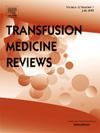Intravenous Iron Therapy Versus Blood Transfusion for Iron Deficiency Anemia: A Systematic Review
IF 2.5
2区 医学
Q2 HEMATOLOGY
引用次数: 0
Abstract
This systematic review aimed to assess and compare the effect of blood transfusion and intravenous iron therapy on the hemoglobin levels based on clinical trials. To do this, a search was conducted 25th of September 2024 by using PubMed, Cochrane, and Embase databases to identify studies comparing intravenous iron with blood transfusion in patients with iron deficiency anemia (<12 g/dL for women and <13 g/dL for men). The outcome selected was change in hemoglobin levels. The quality of the trials was assessed using Cochrane Risk of Bias Tool and Newcastle-Ottawa Quality Assessment Scale. We included 5 studies (three randomized controlled trials, 1 observational study and 1 retrospective study) comprising a total of 154,539 patients. Patient populations were heterogenous, encompassing surgical patients, patients undergoing hip fracture and pregnant women. Due to heterogeneity among the included studies, hemoglobin levels were reported at varying follow-up intervals. At 3 weeks follow-up or later after initial treatment, 3 studies reported significantly higher hemoglobin levels (ranging from 0.7 g/dL to 1.4 g/dL higher) in the intravenous iron group compared to the blood transfusion group. The remaining 2 studies found similar hemoglobin levels. Less than 3 weeks after initial treatment, 2 studies reported significantly higher hemoglobin levels in the blood transfusion group compared to the intravenous iron group. Our findings indicate that blood transfusion is more effective in achieving a rapid increase in hemoglobin levels shortly after therapy initiation, although this effect diminishes relatively swiftly. In contrast, intravenous iron seems to exert a more gradual increase in, but also longer lasting effect on, hemoglobin levels. However, our findings are limited by the small number of trials as well as questionable methodological quality of the included studies, resulting in a high risk of bias. Further investigation is warranted.
静脉铁治疗与输血治疗缺铁性贫血:一项系统综述
本系统综述旨在评估和比较输血和静脉铁治疗在临床试验基础上对血红蛋白水平的影响。为此,我们于2024年9月25日通过PubMed、Cochrane和Embase数据库进行了一项检索,以确定缺铁性贫血患者静脉注射铁与输血的比较研究(女性12g /dL,男性13g /dL)。选择的结果是血红蛋白水平的变化。使用Cochrane偏倚风险评估工具和Newcastle-Ottawa质量评估量表评估试验的质量。我们纳入了5项研究(3项随机对照试验、1项观察性研究和1项回顾性研究),共纳入154,539例患者。患者群体具有异质性,包括手术患者、髋部骨折患者和孕妇。由于纳入研究的异质性,血红蛋白水平在不同的随访时间间隔报告。在初始治疗后3周或更晚的随访中,有3项研究报告,与输血组相比,静脉注射铁组的血红蛋白水平明显更高(从0.7 g/dL到1.4 g/dL不等)。其余两项研究发现了相似的血红蛋白水平。初始治疗后不到3周,2项研究报告输血组的血红蛋白水平明显高于静脉注射铁组。我们的研究结果表明,输血在治疗开始后不久实现血红蛋白水平的快速增加更有效,尽管这种效果相对迅速地减弱。相比之下,静脉注射铁似乎对血红蛋白水平的影响更缓慢,但也更持久。然而,我们的发现受到试验数量少以及纳入研究的方法学质量问题的限制,导致高偏倚风险。有必要进一步调查。
本文章由计算机程序翻译,如有差异,请以英文原文为准。
求助全文
约1分钟内获得全文
求助全文
来源期刊

Transfusion Medicine Reviews
医学-血液学
CiteScore
11.60
自引率
0.00%
发文量
40
审稿时长
21 days
期刊介绍:
Transfusion Medicine Reviews provides an international forum in English for the publication of scholarly work devoted to the various sub-disciplines that comprise Transfusion Medicine including hemostasis and thrombosis and cellular therapies. The scope of the journal encompasses basic science, practical aspects, laboratory developments, clinical indications, and adverse effects.
 求助内容:
求助内容: 应助结果提醒方式:
应助结果提醒方式:


